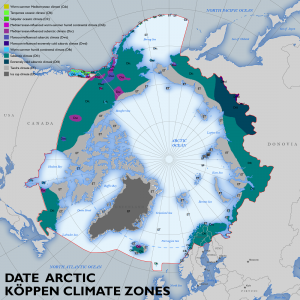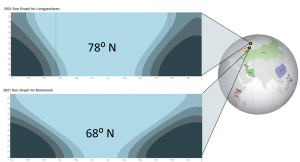Physical Environment: Arctic
Contents
Overview
The Arctic operating environment poses unique physical challenges. Maritime and land areas have conditions not present in other regions of the world. The climate is extreme. The electromagnetic and space environments have accentuated effects. It is also predominantly a maritime environment.
Terrain
Mobility
Trafficability
Arctic ground is generally covered with ice or snow during the winter season. Although frozen ground and ice have good trafficability, deep snow can impede mobility. Vehicles and personnel require special equipment under these adverse conditions. Wheeled vehicles need winterized drive trains, chains or studded snow tires. Dismounted troops will require winter clothing, skis, and snowshoes. Light infantry patrolling dismounted on snowshoes with combat loads and moving tactically have a movement rate of 500 meters per hour.
Night Movement
Night navigation may be good when operating in Arctic terrain. Night movement is not possible in the most northern spots during the summer, as there is no complete darkness. Conversely, night movement is almost 24 hours a day in the winter. Moonlight and starlight on a clear night reflect off the snow, enabling units to employ daytime terrain association techniques with little difficulty. Cloudy winter nights are often brighter than clear moonlit summer nights when the ground is dark and covered with foliage. Movements with total light discipline can often be executed. On the other hand, areas with severe winter climates experience lengthy periods of darkness each day, which may be accompanied by driving snow and limited visibility.
Concealment
Lack of contrast in flat, open areas covered with snow (especially in bright sunlight), may interfere with being able to read the land. With no foliage, concealment from the ground and air is greatly reduced. As in desert areas, units must use terrain to conceal movement. Frozen streams and swamps are passable in the winter, but can become major obstacles to vehicle traffic during the spring thaw and summer months.
Bodies of Water
Major bodies of water include the Arctic Ocean, the Chukchi Sea, the East Siberian Sea, the Laptev Sea, the Kara Sea, the Barents Sea, the Greenland Sea, the Beaufort Sea, the Bering Sea, and Baffin Bay. The Arctic is covered by drifting ice that reaches encircling landmasses during winter and retreats during summer. Sea ice topography varies, with larger features in the central Arctic and near the Canadian coast being associated with multi-year ice. Arctic thawing trends suggest the summer ice sheet and permafrost will decline by double-digit percentages, but ice-free summers will likely not be recurrent before the 2030s at the earliest.
The Arctic Ocean is the smallest of the world?s oceans and is centered on the North Pole. The total area of the Arctic Ocean is 14,090,000 km2 (5,440,000 sq mi). Average depth is 987 m (3,240 ft.) with the deepest point at 5,502 m (18,050 ft.). The Arctic Ocean floor is split by an underwater mountain range (Lomonsov Ridge) making it actually two large basins: the Eurasia Basin and the Amerasia Basin. The Lomonsov Ridge was discovered by Donovian scientists in 1948-1949 and reported in 1954. According to the Encyclopedia Britannica, the ridge ?varies in width from 40 to 120 miles, and its crest ranges in depth between 3,100 and 5,400 feet.?
-34 grams of salt per kilogram. The next layer is 650 ? 3,000 ft and is warmer Atlantic Ocean water. The temperature of this layer is 1-3 C (34--
Sea Lanes
There are three main passages through the Polar Region, the central (or Transpolar) passage, the North-
The transpolar Passage cuts directly across the Arctic Sea and over the North Pole from The Bering Sea to the Greenland Sea between Iceland and Ireland.
The Northeast (NE) Passage, also known as the Northern Shipping Route (NSR) in Europe, moves from the Norwegian Sea along the Donovian coast to the Bering Sea. The NE Passage is more navigable with less ice than the Northwest (NW) Passage, but Donovia imposes a tariff for its use. In contrast, Canada imposes no tariff on the NW. The NE Passage passes through Donovian territorial waters. Donovia maintains the passage with an icebreaker fleet, but also patrols it for security. The proximity to strategic Donovian military naval assets makes the NE Passage a risk for U.S. and European freedom of movement.
Search and Rescue within the Arctic is governed by the Arctic Council through a circumpolar treaty signed by all members, with geographic responsibility for SAR operations divided among the various member states.
Sea Ice
Wind and water keep the ice in constant motion causing cracks, open ponds, and pressure ridges. Pressure ridge can stack very high and reach down in the water 10-25 m (33-80 ft.). Sea ice in the Arctic Ocean generates cold water that drives the circulation of the world ocean system.
Electromagnetic Environment
The Arctic is a unique electromagnetic environment. The Earth?s magnetic field is strongest in the northern polar region, but magnetic north is not the point of maximum magnetic strength. There are two maxima, one in Central Canada and the other in Siberia.
-fitting dipole intersects the surface of the Earth. This theoretical dipole is equivalent to a powerful bar magnet at the center of Earth and comes closer than any other model to accounting for the magnetic field observed at Earth's surface. In contrast, the magnetic poles of the Earth are not antipodal; that is, the line on which they lie does not pass through Earth's center.
The space domain over the Arctic poses unique challenges. Geostationary satellites cannot provide coverage at Arctic latitudes because their line of sight is obstructed by the curvature of the Earth, so all available satellites have moving ground tracks. The Arctic experiences comparatively higher levels of charged particle levels than lower latitudes during ionospheric storms, particularly during winter months. Remote sensing is complicated by extended periods of darkness in the winter. The combined result is a physical environment that has greater influence over other OE variables than is often encountered in lower latitudes. Some physical environment effects, such as climate, vary in amplitude between sub-regions. Other effects, such as day length and electromagnetic interference, remain consistent longitudinally but vary with latitude.
Subterranean Environment
Much of the Arctic is covered by permafrost. Drainage is poor, resulting in boggy wetlands during the brief summer months. The area of permafrost is decreasing annually, which undermines existing infrastructure in many areas. Pockets of subterranean gas may thaw and emerge, leaving enormous sinkholes in their place.
Vegetation
See, Concealment, above.
Agriculture
Climate and Weather
The Arctic climate is characterized by long, dark, cold winters and short, cool summers with continuous daylight. Polar maritime climates near the Atlantic and Pacific coasts generally have milder temperatures and greater amounts of snowfall, while polar continental climates have harsh temperatures and light snowfall. The Arctic Oscillation is a major weather pattern that involves an inverse relationship between Arctic and middle latitude pressures and temperatures. Additionally, small cyclones appear regularly above the Arctic Ocean during winter. Cyclones occur near the Aleutian Islands and Otso; anticyclones occur over Siberia and the Beaufort Sea. Temperatures vary by location. For example, in Omyakon, Siberia, mean temperatures range from ---
The Arctic climate is changing more rapidly than other regions, with annual sea ice minimum volumes at record lows since 2007, although it is uncertain when Arctic seas will be considered ice-
Tundra climate (ET). This climate type is characterized by sub-[[
[2 to 20 inches]), with most occurring on the coastal margins. Most precipitation results from penetration of a cyclone into the region, which brings snow, ice pellets and blizzards with strong winds. High winds also occur in the outer portions of the Greenland climates, where cold, dense air drains off the higher, central sections of the ice caps, known as katabatic winds, also known as down-slope winds. Daily temperature variations are very small, because the presence of snow and ice at the surface refrigerates the air.
Seasons Overview
(See also, Time Variable)
The midnight sun (also known as white nights or polar day) is a natural phenomenon that occurs in the summer months in places north of the Arctic Circle, when the sun remains visible at the local midnight.
Precipitation
The Arctic has low precipitation caused by sinking air in the high---cooled, freezing rain occurs. The drops may freeze on impact with the ground to form a very slippery and dangerous "glazed" ice that is difficult to see because it is almost transparent.
Wind
Wind speeds over the Arctic Basin and the western Canadian Archipelago average between four and six meters per second (14 and 22 kilometers per hour [km/h], nine and 13 miles per hour [mph]) in all seasons. Stronger winds do occur in storms, often causing whiteout conditions, but they rarely exceed 25 meters per second (90 km/h, 55 mph) in these areas.
During all seasons, the strongest average winds are found in the North Atlantic seas, Baffin Bay, Bering Sea, and Chukchi Sea, where cyclone activity is most common. On the Atlantic side, the winds are strongest in winter, averaging seven to 12 m/s (25 to 43 km/h, 16 to 27 mph), and weakest in summer, averaging five to seven m/s (18 to 25 km/h, 11 to 16 mph). Maximum wind speeds in the Atlantic region can approach 50 m/s (180 km/h, 110 mph) in winter. On the Pacific side they average six to nine m/s (22 to 32 km/h, 13 to 20 mph) year-round.
Visibility
Extensive snow and ice pose challenges to imaging, as terrain variations can be difficult to discern.
Hazards
Natural hazards include ice islands and icebergs in maritime areas, permafrost on land, and extreme temperatures. Permafrost is receding in all regions. This could potentially result in the reemergence of pathogens preserved in permafrost and facilitate the northward spread of current, geographically restricted pathogens.
Events
Disease
There are few if any significant localized disease phenomena in the Arctic. Personnel assigned to high latitudes are at higher risk of developing sleep and affective disorders that are deleterious to efficiency. These are associated with the extreme periods of daylight in summer and darkness in winter.
Flora
Fauna
Black, brown, and polar bears are all native to the Arctic. Black bears will generally only attack if surprised or threatened. Brown bears and polar bears will hunt humans. Wolves and lynxes are unlikely to attack humans unless injured and/or isolated. Moose will attack if surprised or threatened and will defend their territory. Marine mammals including walruses and sea lions can be dangerous if surprised or threatened. Some insects survive north of the Arctic, particularly the low Arctic region, including flies and mosquitos that thrive in the high-




